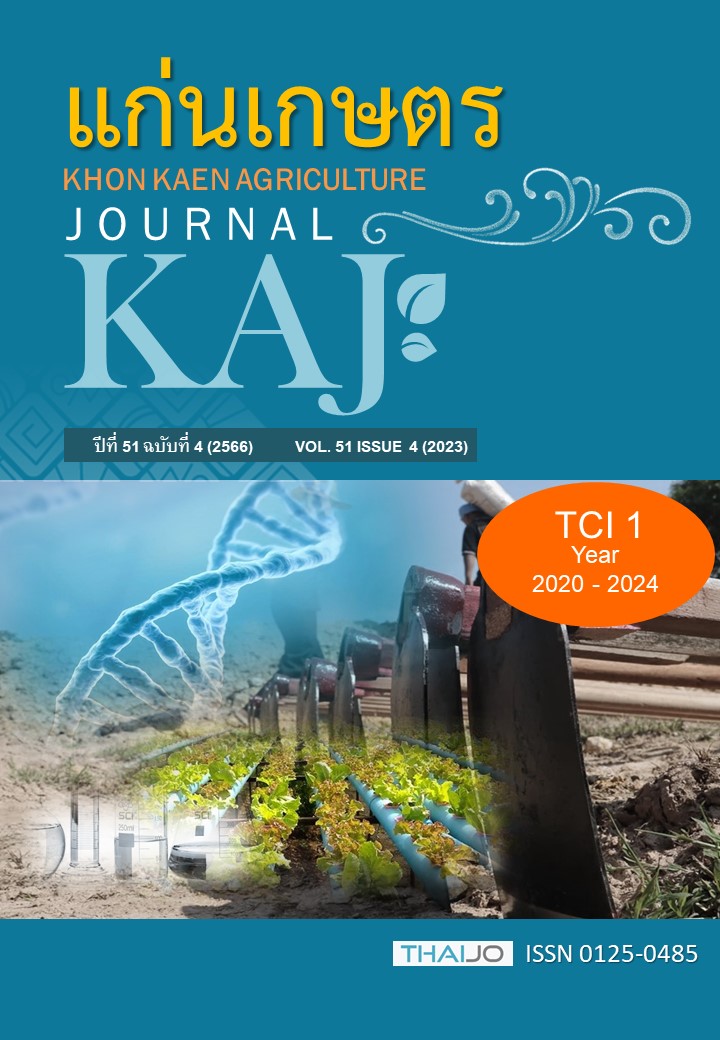การตรวจหายีนต้านทานโดยใช้เครื่องหมายดีเอ็นเอ ร่วมกับการประเมินระดับความต้านทานต่อการเข้าทำลายของเพลี้ยกระโดดสีน้ำตาลในข้าวสายพันธุ์พื้นเมืองที่ปลูกในบางพื้นที่ของภาคเหนือตอนล่าง ประเทศไทย
Main Article Content
บทคัดย่อ
เพลี้ยกระโดดสีน้ำตาล (brown planthopper, Nilaparvata lugens) เป็นแมลงศัตรูข้าวที่สำคัญในประเทศไทย สามารถปรับตัวให้เข้ากับสภาพแวดล้อมได้ดี ทำให้ยากต่อการควบคุม ประเทศไทยนับเป็นแหล่งความหลากหลายทางพันธุกรรมข้าว โดยเฉพาะข้าวสายพันธุ์พื้นเมืองที่เป็นแหล่งของยีนต้านทานแมลงที่สำคัญ สามารถนำมาใช้ในการปรับปรุงพันธุ์ข้าวให้มีลักษณะต้านทานต่อแมลงในอนาคต งานวิจัยนี้ทำการตรวจสอบยีนต้านทานเพลี้ยกระโดดสีน้ำตาล โดยใช้เครื่องหมายดีเอ็นเอที่มีความจำเพาะต่อยีน Bph3, Bph14 และ Bph18(t) ร่วมกับการประเมินระดับความต้านทานในข้าวสายพันธุ์พื้นเมือง จำนวน 20 สายพันธุ์ พบว่าข้าวทั้ง 20 สายพันธุ์ มียีนต้านทานเพลี้ยกระโดดสีน้ำตาลอย่างน้อย 1 ยีน โดยข้าวสายพันธุ์พื้นเมือง 2 สายพันธุ์ คือ ข้าวหอมดงและข้าวล้นครกมียีนต้านทานเพลี้ยกระโดดสีน้ำตาลทั้ง 3 ยีน (Bph3, Bph14 และ Bph18(t)) และเมื่อประเมินระดับความต้านทานต่อการเข้าทำลายของเพลี้ยกระโดดสีน้ำตาล พบว่าข้าวหอมดงมีระดับความต้านทานเมื่อประเมินในวันที่ 7 และ 14 อยู่ที่ระดับต้านทาน (R) และต้านทานปานกลาง (MR) ตามลำดับ แต่ข้าวล้นครกมีระดับความต้านลดลงไปอยู่ระดับอ่อนแอ (S) ในวันที่ 14 ส่วนข้าวเหลืองเกษตรและข้าวขาวชะลอ มีความต้านทานในระดับเดียวกับข้าวหอมดง แต่มียีนต้านทานเพียง 1 ยีน (Bph3) ข้าวสายพันธุ์พื้นเมืองแต่ละสายพันธุ์มีระดับความต้านทานแตกต่างกันอย่างมีนัยสำคัญทางสถิติ ดังนั้นข้าวสายพันธุ์พื้นเมืองยังมีความแปรผันทางพันธุกรรมที่เป็นประโยชน์ต่อการนำมาใช้ในการพัฒนาพันธุ์ข้าวให้มีความต้านทานต่อเพลี้ยกระโดดสีน้ำตาลได้ต่อไป
Article Details

อนุญาตภายใต้เงื่อนไข Creative Commons Attribution-NonCommercial-NoDerivatives 4.0 International License.
เอกสารอ้างอิง
กองวิจัยและพัฒนาข้าว กรมการข้าว. 2563. สรุปรายงานสถานการณ์ศัตรูข้าว กรมการข้าว. แหล่งข้อมูล: http://brrd.ricethailand.go.th/index.php/2016-07-15-05-32-35/726-17-23-2564. สืบค้นเมื่อ 30 เมษายน 2564.
จิรพงศ์ ใจรินทร์, วราภรณ์ วงศ์บุญ, กิจติพงษ์ เพ็งรัตน์, สงวน เทียงดีฤทธิ์, พิกุล ลีลากุด และกัลยา สานเสน. 2552. การพัฒนาสายพันธุ์ข้าวต้านทานเพลี้ยกระโดดสีน้ำตาลและมีคุณภาพเมล็ดเหมือนขาวดอกมะลิ 105 โดยใช้โมเลกุลเครื่องหมาย. น.187-207. ใน: การประชุมวิชาการข้าวและธัญพืชเมืองหนาว วันที่ 9-11 มิถุนายน 2552. ณ โรงแรมซีนรีซ จอมเทียน รีสอร์ท พัทยา จังหวัดชลบุรี.
ฐานัฎ ณ พัทลุง และวิภา ตังคนานนท์. 2560. พฤติกรรมการทำลายข้าวของเพลี้ยกระโดดสีน้ำตาล ในพื้นที่นาชลประทานภาคกลางของประเทศไทย. Thai Journal of Science and Technology. 6(4): 369-391.
Cha-um, S., S. Roytakul, T. Sathung, A. Maijandang, and C. Kridmanee. 2007. Effect of exogenous glucose and abscisic acid on physiological and morphological performances of in vitro Indica Rice (Oryza sativa L. sp. indica.). American Journal of Plant Physiology. 2: 155-166.
Collard, B.C.Y., and D.J. Markill. 2008. Marker-assisted selection: an approach for precision plant breeding in the twenty-first century. Philosophical Transactions of The Royal Society B Biological Sciences. 363(1491): 557–572.
Doyle, J.J., and J.L. Doyle. 1987. A rapid DNA isolation procedure for small quantities of fresh leaf tissue. Phytochemical Bulletin. 19(1): 11-15.
Du, B., W. Zhang, B. Liu, J. Hu, Z. Wei, Z. Shi, R. He, L. Zhu, R. Chen, B. Han, and G. He. 2009. Identification and characterization of Bph14, a gene conferring resistance to brown planthopper in rice. Proceedings of the National Academy of Sciences. 106(52): 22163–22168.
Flor, H.H. 1942. Inheritance of pathogenicity in Melampsora lini. Journal of Phytopathology. 32(8): 653–669.
Haliru, B.S., M.Y. Rafii, N. Mazlan, S.I. Ramlee, I. Muhammad, I.S. Akos, J. Halidu, S. Swaray, and Y.R. Bashir. 2020. Recent Strategies for Detection and Improvement of Brown Planthopper Resistance Genes in Rice: A Review. Plants-Basel. 9(9): 1202.
Hao, P.Y, C.X. Liu, Y.Y. Wang, R.Z. Chen, M. Tang, B. Du, L.L Zhu, and G.C. He. 2008. Herbivore-induced callose deposition on the sieve plates of rice: an important mechanism for host resistance. Plant Physiology. 146: 1810–1820.
Hu, J., J. Zhou, X. Peng, H. Xu, C. Liu, B. Du, H. Yuan, L. Zhu, and G. He. 2011. The Bphi008a gene interacts with the ethylene pathway and transcriptionally regulates MAPK genes in the response of rice to brown planthopper feeding. Plant Physiology. 156(2): 856–872.
Hu, J., C. Xiao, and Y. He. 2016. Recent progress on the genetics and molecular breeding of brown planthopper resistance in rice. Rice. 9: 30.
HU, W., X.Y. Deng, X. Deng, L. Deng, Y. Xiao, X.J. HE, X. FU, and G. Xiao. 2018. Characteristic analysis of tetra-resistant genetically modified rice. Journal of Integrative Agriculture. 17(3): 493–506.
IRRI. 2013. Standard Evaluation System (SES) for Rice. 5th Edition. International Rice Research Institute, Manila, Philippines.
Jairin, J., K. Phengrat, S. Teangdeerith, A. Vanavichit, and T. Toojinda. 2007. Mapping of a broad spectrum brown planthopper resistance gene, Bph3, on rice chromosome 6. Molecular Breeding. 19: 35-44.
Jena, K.K., J.U. Jeung, J.H. Lee, H.C. Choi, and D.S. Brar. 2006. High resolution mapping of a new brown planthopper (BPH) resistance gene, Bph18(t), and marker-assisted selection for BPH resistance in rice (Oryza sativa L.). Theoretical and Applied Genetics. 112: 288–297.
Jena, K.K., and S.M. Kim. 2010. Current status of brown planthopper (BPH) resistance and genetics. Rice. 3: 161–171.
Jena, M., R. S. Panda, R. K. Sahu, A. K. Mukherjee, and U. Dhua. 2015. Evaluation of rice genotypes for rice brown plant hopper resistance through phenotypic reaction and genotypic analysis. Crop Protection. 78: 119-126.
Jing, S., Y. Zhao, B. Du, R. Chen, L. Zhu, and G. He. 2017. Genomics of interaction between the brown planthopper and rice. Current Opinion in Insect Science. 19: 82-87.
Kobayashi, T. 2016. Evolving ideas about genetics underlying insect virulence to plant resistance in rice-brown planthopper interactions. Journal of Insect Physiology. 84: 32-39.
Kumar, A.D.V.S.L.P, R.N. Mallikharjuna, and C.V. Rama Rao. 2021. Impact of insecticides on feeding of rice brown planthopper, Nilaparvata lugens (stal.). Multilogic in Science. 12(40): 106-109.
Muduli, L., S. K. Pradhan, A. Mishra, D. N. Bastia, K. C Samal, P. K. Agrawal, and M. Dash. 2021. Understanding Brown Planthopper Resistance in Rice: Genetics, Biochemical and Molecular Breeding Approaches. Rice Science. 28(6): 532-546.
Mullis, K., F. Faloona, S. Scharf, R. Saiki, G. Horn, and H. Erlich. 1986. Specific enzymatic amplification of DNA in vitro: the polymerase chain reaction. Cold Spring Harbor Symposia on Quantitative. 51(1): 263-273.
Nogoy, F.M., J.Y. Song, S. Ouk, S. Rahimi, S.W. Kwon, K.K. Kang, and Y.G. Cho. 2016. Current Applicable DNA Markers for Marker Assisted Breeding in Abiotic and Biotic Stress Tolerance in Rice (Oryza sativa L.). Plant Breeding and Biotechnology. 4(3): 271-284.
Pati, P., M. Jena, S. Bhattacharya, M. Annamalai, S. Raghu, S.K. Behera, P. Sanghamitra, G. Pandi, and S. K. Meena. 2019. Evaluation of red rice genotypes against brown planthopper, BPH (Nilaparvata lugens Stal.) by phenotypic analysis and study of mechanism of resistance involved. Journal of Entomology and Zoology Studies. 7(5): 149-155.
Pusadee, T., P. Oupkaew, B. Rerkasem, S. Jamjod, and B.A. Schaal. 2014. Natural and human-mediated selection in a landrace of Thai rice (Oryza sativa). Annals of Applied Biology. 165(2): 280-292.
Watanabe, T., and H. Kitagawa. 2000. Photosynthesis and translocation of assimilates in rice plants following phloem feeding by the planthopper Nilaparvata lugens (Homoptera: Delphacidae). Journal of Economic Entomology. 93: 1192-1198.
Zhi-juan, J., Y. Shu-dong, Z. Yu-xiang, L. Yan, Y. Chang-deng, and Q. Qian. 2016. Pyramiding blast, bacterial blight and brown planthopper resistance genes in rice restorer lines. Journal of Integrative Agriculture. 15(7): 1432–1440.


